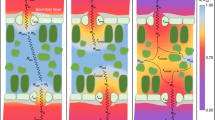Summary
The responses of photosynthesis, transpiration and leaf conductance to changes in vapour pressure deficit were followed in well-watered plants of the herbaceous species, Helianthus annuus, Helianthus nuttallii, Pisum sativum and Vigna unguiculata, and in the woody species having either sclerophyllous leaves, Arbutus unedo, Nerium oleander and Pistacia vera, or mesomorphic leaves, Corylus avellana, Gossypium hirsutum and Prunus dulcis. When the vapour pressure deficit of the air around a single leaf in a cuvette was varied from 10 to 30 Pa kPa-1 in 5 Pa kPa-1 steps, while holding the remainder of the plant at a vapour presure deficit of 10 Pa kPa-1, the leaf conductance and net photosynthetic rate of the leaf decreased in all species. The rate of transpiration increased initially with increase in vapour pressure deficit in all species, but in several species a maximum transpiration rate was observed at 20 to 25 Pa kPa-1. Concurrent measurements of the leaf water potential by in situ psychrometry showed that an increase in the vapour pressure deficit decreased the leaf water potential in all species. The decrease was greatest in woody species, and least in herbaceous species. When the vapour pressure deficit around the remainder of the plant was increased while the leaf in the cuvette was exposed to a low and constant vapour pressure deficit, similar responses in both degree and magnitude in the rates of transpiration and leaf conductance were observed in the remainder of the plant as those occurring when the vapour pressure deficit around the single leaf was varied. Increasing the external vapour pressure deficit lowered the water potential of the leaf in the cuvette in the woody species and induced a decrease in leaf conductance in some, but not all, speies. The decrease in leaf conductance with decreasing water potential was greater in the woody species when the vapour pressure deficit was increased than when it remained low and constant, indicating that changing the leaf-to-air vapour pressure difference had a direct effect on the stomata in these species. The low hydraulic resistance and maintenance of a high leaf water potential precluded such an analysis in the herbaceous species. We conclude that at least in the woody species studied, an increase in the vapour pressure deficit around a leaf will decrease leaf gas exchange through a direct effect on the leaf epidermis and sometimes additionally through a lowering of the mesophyll water potential.
Similar content being viewed by others
References
Black CR, Squire GR (1979) Effects of atmospheric saturation deficit on the stomatal conductance of pearl millet (Pennisetum typhoides S. and H.) and groundnut (Arachis hypoguesa L.). J Exp Bot 30:935–945
Brown PW, Tanner CB (1981) Alfalfa water potential measurements: a comparison of the pressure chamber and leaf dewpoint hygrometers. Crop Sci 21:240–244
Hall AE, Schulze E-D (1980) Stomatal response to environment and a possible interrelation between stomatal effects on transpiration and CO2 assimilation. Plant Cell Environ 3:467–474
Heiser CB (1951) The sunflower among the North American Indicans. Proc Am Philos Soc 95:432–448
Hoch HC, Pratt C, Marx GA (1980) Subepidermal air spaces: basis for the phenotypic expression of the argenteum mutant of Pisum. Am J Bot 67:905–911
Jarvis PG (1980) Stomatal response to water stress in conifers. In: Turner NC, Kramer PJ (eds) Adaptation of plants to water and high temperature stress. Wiley-Interscience, New York, pp 105–122
Johnson JD, Ferrell WK (1983) Stomatal response to vapour pressure deficit and the effect of plant water stress. Plant Cell Environ 6:451–456
Lange OL, Lösch R, Schulze E-D, Kappen L (1971) Responses of stomata to changes in humidity.Planta 100:76–86
Lösch R (1979) Stomatal responses to changes in air humidity. In: Sen DN, Chawan DD, Bansal RP (eds) Structure, function and ecology of stomata. Bishen Singh Mahendra Pal Singh, Dehra Dun, pp 189–216
Ludlow MM (1980) Adaptive significance of stomatal responses to water stress. In: Turner NC, Kramer PJ (eds) Adaptation of plants to water and high temperature stress. Wiley-Interscience, New York, pp 123–138
Maier-Maercker U (1983) The role of peristomatal transpiration in the mechanism of stomatal movement. Plant Cell Environ 6:369–380
Osonubi O, Davies WJ (1980) The influence of plant water stress on stomatal control of gas exchange at different levels of atmospheric humidity. Oecologia (Berl) 46:1–6
Rawson HM, Begg JE, Woodward RG (1977) The effect of atmospheric humidity on photosynthesis, transpiration and water use efficiency of leaves of several plant species. Planta 134:5–10
Schulze E-D, Hall AE (1982) Stomatal responses, water loss and CO2 assimilation rates of plants in contrasting environments. In: Lange OL, Nobel PS, Osmond CB, Ziegler H (eds) Physiological plant ecology II. Encyclopedia of plant physiology. New Series, Volume 12B, Springer, Berlin, pp 181–230
Schulze E-D, Küppers M (1979) Short-term and long-term effects of plant water deficits on stomatal response to humidity in Corylus avellana L. Planta 146:319–326
Sheriff DW (1979) Stomatal aperture in the sensing of the environment by guard cells. Plant Cell Environ 2:15–22
Turner NC, Spurway RA, Schulze E-D (1984) Comparison of water potentials measured by in situ psychrometry and pressure chamber in morphologically different species. Plant Physiol 74:316–319
Author information
Authors and Affiliations
Rights and permissions
About this article
Cite this article
Turner, N.C., Schulze, ED. & Gollan, T. The responses of stomata and leaf gas exchange to vapour pressure deficits and soil water content. Oecologia 63, 338–342 (1984). https://doi.org/10.1007/BF00390662
Received:
Issue Date:
DOI: https://doi.org/10.1007/BF00390662




